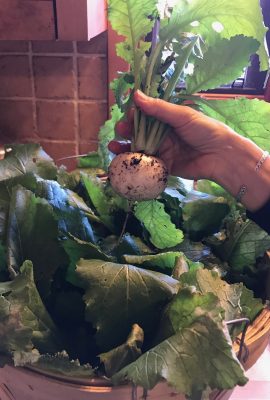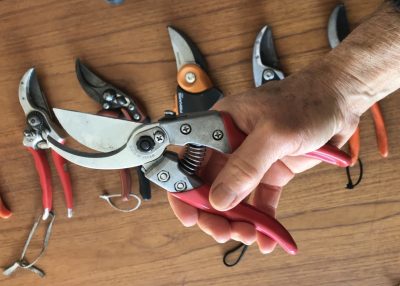Shears Galore
/8 Comments/in Pruning/by Lee Reich
For Those Smaller Cuts
What gardener doesn’t need to prune some thing at some time? In many cases, a thumbnail suffices, as when pinching out the growing tip of a marigold or basil plant to make it grow more bushy. Or pinching off the soft green tip of a young apple shoot to temporarily stall its growth and let the leader, destined (by you) to be the future trunk and main limb, to remain top dog. Your thumbnail, though, isn’t always sufficiently long to use as a pruning tool, or else stems have toughened up beyond your thumbnail’s capabilities.
When more than your thumbnail is needed, there are many pruning tools from which to choose. If you’re going to own but one pruning tool, that tool should probably be a pair of hand shears, which are useful for cutting stems up to about 1/2” across.
As with everything these days from cold cereals to corn chips to soaps, a wide, confusing array confronts you whether in a catalog, the web, or a store shelf. Having written a book about all aspects of pruning, inc

Bypass blade (left) vs anvil blade (right)
luding the tools of the trade (The Pruning Book), I’ve been afforded the opportunity to try out a slew of pruning shears. Looking for a pair to buy? I’m going to make it easier for you
Okay, okay, personal taste does come into play here. That’s why the ideal is to be able to fondle a candidate before purchase or, even better, try it out. Still, some general design features are important to function.
The blades, for instance. Blade configurations fall into one of two categories: anvil and bypass (the latter sometimes called “scissors”). The business end of the anvil-type shears consists of a sharp blade that comes down on top of an opposing blade having a flat edge. The flat edge is made of plastic or a soft metal so as not to dull the sharp edge. Bypass pruners work more like scissors, with two sharpened blades sliding past each other.
Anvil shears generally are cheaper than bypass shears — and the price difference is reflected in the resulting cut! Unless the single, sharp blade is kept truly sharp, the anvil pruner will crush part of the stem. And if the two blades do not mate perfectly, the cut will be incomplete, leaving the two pieces of the stem attached by threads of tissue. That wide, flattened blade also makes it more difficult to get the tool right up against the base of the stem you want to remove.
The blades of some bypass shears are hooked at their ends to help prevent stems from slipping free of the jaws as you cut. Other shears achieve the same effect with a rolling action of one bypass blade along the other as the handle is squeezed.Beyond blade design, certain special features found on some pruning shears might appeal to you personally. Some shears are tailored to fit left hands or small hands, although on some of the latter the effect is achieved by merely shrinking the maximum blade opening when adjusted to the smaller hand size.
To make it easier to slice through thick stems, some shears have a ratchet action; weigh the virtue of more power against the need for repeatedly squeezing the handles for each cut. Other shears (allegedly) ease hand strain by having models with hand grips that rotate as you make the cut and/or varying the angle of the blades in relation to the handles.
And My Favorite Pruning Shear Is . . .
I have a collection of pruning shears and they all hang on the wall near the back door. A good test of how I actually feel about a particular pruning shear is how frequently I grab it as I go out the door.
I have narrowed down my favorites to three, which are . . . ‘rat-a-tat-tat’ drum roll. Well, it depends on what I’m pruning. If it’s just light pruning, I generally reach for my Pica shears, a model that should be better known. They’re light but sturdy, and their blades are hooked at their ends to (I guess) help prevent stems from slipping free of the jaws as you cut.
For the heaviest cuts I’d make with a hand shears, I reach for my Felco No. 7, universally recognized as great shears by those in the know. It has a nice feel, although a little topheavy, and the blades are of high quality steel and are replaceable, as are most parts.
My favorite all-around shear, the one I’d get if I could own only one shear (shudder the thought!), is my ARS VS-8 pruner.
Not a catchy name, but a top notch pruner with good weight, good steel, replaceable parts, and — my favorite part — easily opened with just a firm squeeze of the handles.
So there they are, my recommendations. Consider these before making an impulse purchase for whatever shear happens to be staring you in the face.
Dry, Wet, Bad, Good?
/10 Comments/in Fruit, Gardening, Pests, Soil, Vegetables/by Lee ReichSome Bad
Wow! What a gardening year this has been. Looking back on 2018, it’s been the oddest year ever in terms of weather, insects, and disease.
After starting off the season parched, seemingly ready to go into drought, the weather in July did an about face. The rains began. Average precipitation here in the Northeast is about 4 inches per month. July ended up with about 6 inches, August saw 5 inches, September 8 inches(!), October 5 inches, and November 8 inches(!!).
All that rainfall brought humidity, which might have been responsible for my celeriac plants hardly growing, then rotting.

Celeriac, early in the growing season, before the rains
(Perhaps not, because this was my third growing season of failure with celeriac.) I’m taking this as a celeriac challenge. Perhaps next year I’ll try them in a large tub where I can have more control over soil composition and moisture.
The humidity also had too many figs morph into fuzzy, gray balls as they softened and sweetened.
Tomatoes this year tasted very good, as usual, but yield was way down and too many showed some rotting areas. (In my experience, growing tomatoes under variable soil and weather at various locations around the country, their flavor is mostly a matter of genetics; a good variety tastes good everywhere.) Particularly irking was anthracnose disease, which often isn’t noticeable when fruits are harvested, but quickly shows up as round, sunken areas.
Onions suffered this season. Mostly they were stunted, and I’m not sure why.
Zucchini was a bust because the plants petered out from powdery mildew and vine borers just after midsummer. I usually circumvent these common problems with multiple plantings, starting new zucchini plants in early summer to replace the decrepit ones. I forgot to replant this summer (probably because I don’t like zucchini all that much anyway).
Medlar is an uncommon, very old-fashioned fruit that I’ve grown for many years. Although it’s gotten a bad rap for it’s ugly — to some people — appearance, the flavor is delicious, the soft flesh creamy smooth like apple butter with a similar flavor livened with vinous overtones. 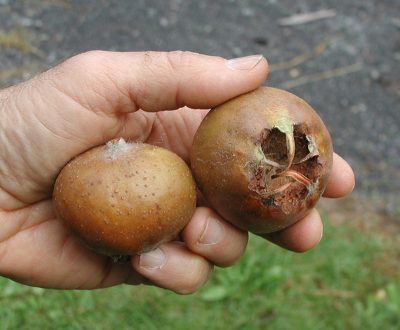 Usually the plant is pest-free but a few years ago something, perhaps a fungus, perhaps an insect, started attacking it, leaving the flesh dry and crumbly. I have yet to identify the culprit so that appropriate action can be taken.
Usually the plant is pest-free but a few years ago something, perhaps a fungus, perhaps an insect, started attacking it, leaving the flesh dry and crumbly. I have yet to identify the culprit so that appropriate action can be taken.
Some Good
Not that this past growing season was bad. I won the battle against soft scale insects (mealybugs) on my greenhouse figs, although their ecological niche was filled by just-as-bad armored scale insects. A close eye and an occasional spray of Neem oil kept flea beetles at bay from eggplants.
A couple of the same Neem sprays beginning in mid-September may have kept a new pest in the area, Allium leafminer (ALM, Phytomyza gymnostoma) at bay. Last year each of my near perfect-looking leeks revealed a rotted stalk as I lifted them out of the ground.
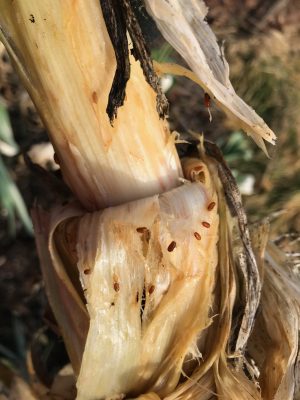
Allium leafminer
Then again, I did plant this past season’s leeks far from where the previous season’s leeks grew. Then again, the ALM flies can fly. Then again, maybe they weren’t here this year; perhaps the weather was not to their liking.
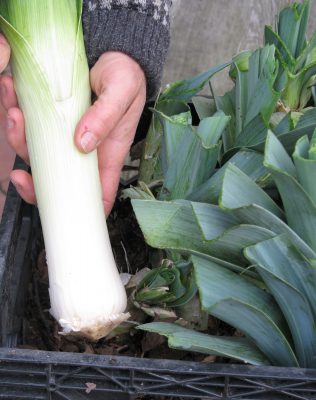
This past season’s leeks
There was also no sign this past season of the white flies that decimated my kale the previous season.
Spotted wing drosophila (SWD), a species of fruit fly that has invaded the country relatively recently, did mostly ruin autumn ripening yellow and black raspberries. But little damage was suffered by my favorite (and perennially most successful) fruit, blueberries, probably thanks to some experimental traps developed by Peter Jentsch of Cornell University.
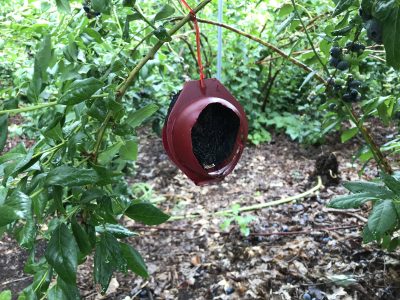
SWD trap
Peppers were even more of a success than usual, mostly due to my staking the plants. The only fault of Sweet Italia, my favorite variety for its early ripening, for its flavor, and for its good yields, is that the fruit-laden plants flop over under their own weight. Eventually, the small bamboo stakes I used proved only partially adequate; next year they’ll get the stakes they deserve.
I treated a few beds in spring to a relatively new method for weed control: tarping. Laying a sunlight-blocking tarp down on the ground for a couple of weeks or more in spring warms the soil beneath, stimulating germination of any weed seeds lurking there. The sprouting seeds are disappointed by the incessant darkness. They die. Timing, temperature, sunlight, and duration of tarping all play a role in this techniques effectiveness.
(Tarping is very different from using black plastic mulches. The latter are kept in place all season long, with garden plants growing in holes or slits in the plastic. Soil beneath the plastic can suffer from lack of air or, if not drip irrigated, lack of water. Also, the tarp — mine came from www.billboardtarps.com — can be folded up and re-used for many seasons.)
And finally, we were happy to find some assassin bugs and anchor stink bugs, Stiretrus anchorago, in the garden. Both are beneficial insects — yes even that particular stink bug.

Immature beneficial stink bug
Good Overall
All in all, it was a good season — as always. The secret is to grow many different kinds of plants. No season, no matter what the weather or pests, has ever been bad for all plants.
Mystery Solved, and Frigid Dealings
/5 Comments/in Gardening, Vegetables/by Lee ReichMystery Plant: No longer a Mystery
Last week I mentioned my brother’s mystery shrub, which he wanted to prune back heavily. I told him it was okay to do so even though I — and a number of experts I consulted — could not identify the plant.
(Drum roll . . .) The plant has finally been identified, by Mark Brand of the University of Connecticut, as Wilson rhododendron, Rhododendron x laetevirens. I had narrowed it down to R. carolinianum, which is one of the parents of this hybrid, the other being R. ferrigineum.
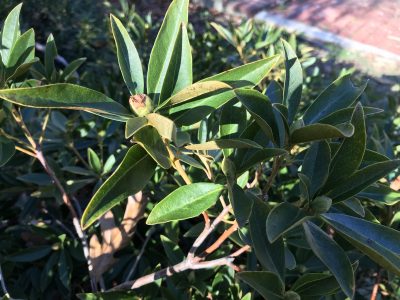
Wilson rhododendron flower bud
My brother’s not noticing flowers on this rhododendron is understandable. It’s a super cold hardy but sparse bloomer that’s grown mostly for its foliage; the pointy leaves don’t droop or curl, but remain perky, even in frigid weather.
Now I can sleep nights.
It was Cold Outside!
Talk about frigid weather: I was surprised at how cold it was on the farmden during my Thanksgiving visit to my bro’ in Rhode Island. The night of Friday, November 23rd, New Paltz weather reported a low of 7° F. Brrrrr. As I’ve mentioned before, I live in a valley. Cold air, which is heavier than warm air, sinks into low spots, bringing the temperature right out in my garden even lower, down to 3° F.
(I knew this even when in Rhode Island, thanks to Sensorpush, a nifty device that transmits minute by minute temperature and humidity conditions to my cell phone from wherever the device is located.)
It’s all about microclimates, which are localized differences from the general climate due to such influences as heat-absorbing masonry walls and paths, which keep temperatures warmer in winter. Or nearby bodies of water, which keep temperatures warmer in winter and cooler in summer. Or differences in elevation, lowering the temperature 6°F for every 1000 feet of elevation, and low lying areas.
Lower temperatures with elevation might seem contradictory to the locally colder temperatures in my garden that night. These colder temperatures occur only when still windless air and a clear sky let any heat the ground has accumulated by day re-radiate back to the heavens. A cloudy night or tree cover would reflect that re-radiated heat back downwards, preventing the cooling. With radiative cooling, air near the ground is coldest, and and warmer air hovers higher up.
Microclimate Adjustment=Fresh Salad Greens
As a gardener, I can play around with microclimate and have it work for me, as evidenced from the fresh endive, winter radishes, lettuce, and turnips just harvested from right out in the garden.
Preparation for that harvest began in late summer with spreading compost in the bed and the sowing of endive seeds. I planted turnip, lettuce, and winter radish seeds in the bed in September.
Back in early October I spaced metal hoops 4 feet apart along the bed, each one spanning from one side to the other of the bed. Later on in October, I covered the hoops with a length of clear plastic, slitted row cover creating a tunnel over the bed. The slits keep the interior of this mini-greenhouse from overheating.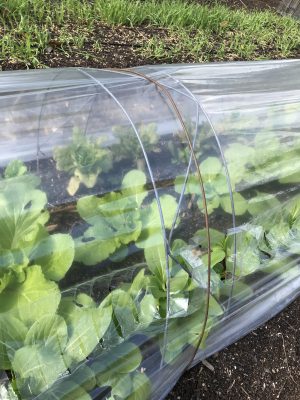
Moving into November, temperatures gradually cooled but still not enough to threaten the covered plants. Between the plants natural cold hardiness and the cover, I figured they were fine into the low 20s. (For more on microclimates and their manipulation, see my new book The Ever Curious Gardener.)
Short days and low hanging sun, coupled with cool temperatures, were not providing conditions for plant growth. But the plants were, by then, fully grown, so no more growth was needed. At that point I laid a cloth cover over the tunnel to keep out further depths of cold. Light became immaterial; I just wanted the plants alive and fresh.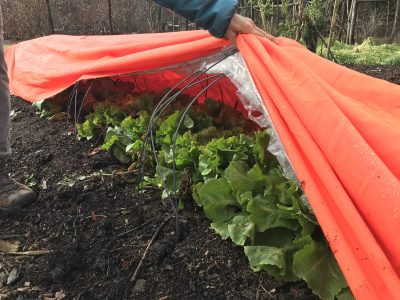
And so they have remained, even after temperatures plummeted to 3°.
Not only are the plants alive and fresh. Cold temperatures have brought out the best in their flavor. The veggies are crisp, sweet, and tangy.